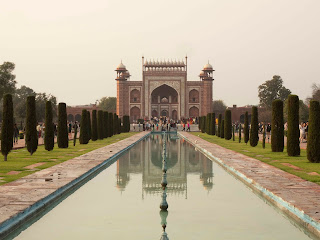Day 5: Agra to Jaipur
Woke this morning to threatening rain clouds and thunder. It looked as if the sunrise was going to be a washout. By the time we arrived at the Taj entrance, the clouds seemed to be starting to break up and perhaps clear.
An hour later, we had some variable clouds with sun peeking through.
Some local attached on to us and dragged us from one ideal picture spot to another.
These were taken from within the Mosque at the side of the mausoleum.
We went back to the hotel for breakfast and then off to Jaipur. Before leaving Agra, though, we stopped at an inlaid marble factory, where we saw demonstrations of the intricate art used in the Taj Mahal of pieta dura.
A depression is etched in the marble, then small semiprecious stones are cut and shaped to accurately fit into the depression. They are glued in with a "secret recipe". The finished product is completely smooth.
The concept here is similar to the Murano glassworks; show them the factory and how much work it is to produce these works of art, then sell!
 |
| Our personal salesman, Rais |
We loved this piece ($14000)
Lighter in the wallet, we continued driving another 2 1/2 hours to a lunch spot set in a bird sanctuary. Peacocks, the national bird, were everywhere.
After lunch we pressed onward to Jaipur.
 |
| Cow dung stacks instead of firewood piles we have at home. |
 |
| Making cow pies for fuel |
 |
| Blues Brothers truck, mobile loudspeaker for weddings |
As the day faded, we made a slight detour to the Abenhari Stepwell (Chand Baori). Stepwells are examples of the many types of storage and irrigation tanks that were developed in India, mainly to cope with seasonal fluctuations in water availability. A basic difference between stepwells on the one hand, and tanks and wells on the other, is to make it easier for people to reach the groundwater and to maintain and manage the well a series of steps were cut.
Tourists from Agra wanted to have our picture taken with them. Westerners are still celebrities.
Harshat Mata Hindu temple adjacent to the stepwell. |
| Mahindra tractors are big here. |





















































No comments:
Post a Comment